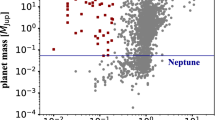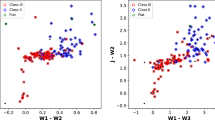Abstract
Planetesimals are thought to form within the dense dust disks that surround young stars1, although this process has not been observed directly. In contrast, the presence of dust disks around older, main-sequence stars can be used to infer that planetesimal formation has indeed occurred; dust is rapidly depleted in circumstellar environments, so a continuous supply of dust by the sublimation and collisional erosion of pre-existing planetesimals2,3 is required to maintain a disk over the lifetime of the central star. The composition of the dust in such disks should provide clues regarding the composition of the planetesimals, and the structure of the disks (for example, gaps in the dust distribution) could be linked to physical interactions with unseen planets. To date, only one main-sequence star—β Pictoris—has been shown to have a dust disk that can be resolved optically4. Here we report the optical image of a candidate dust disk surrounding a main-sequence binary stellar system, BD+31°643. If the existence of this dust disk is confirmed by future observations, it would imply that binary stars may possess stable environments for planetesimal formation.
Similar content being viewed by others
References
Weidenschilling, S. J. & Cuzzi, J. N. Protostars and Planets III (eds Levy E. H. & Lunine, J. I.) 1031–1060 (Univ. Arizona Press, Tucson, 1993).
Nakano, T. Mon. Not. R. Astron. Soc. 230, 551–571 (1988).
Backman, D. E. & Paresce, F. in Protostars and Planets III (eds Levy, E. H. & Lunine, J. I.) 1253–1304 (Univ. Arizona Press, Tucson, 1993).
Smith, B. A. & Terrile, R. J. Science 226, 1421–1424 (1984).
Smith, B. A. & Terrile, R. J. Bull. Am. Astron. Soc. 19, 829 (1987).
Kalas, P. & Jewitt, D. Astron. J. 110, 794–804 (1995).
Lagage, P. O. & Pantin, E. Nature 369, 628–630 (1994).
Artymowicz, P. in Proc. IAP Meeting on Circumstellar Dust Disks and Planet Formation (eds Ferlet, R. & Vidal-Madjar, A.) 47–65 (Editions Frontieres, Paris, 1994).
Kalas, P. & Jewitt, D. Bull. Am. Astron. Soc. 25, 1353 (1993).
Hubble, E. Astrophys. J. 56, 400–438 (1922).
Witt, A. N. & Schild, R. E. Astrophys. J. Suppl. Ser. 62, 839–852 (1986).
Zinnecker, H., McCaughrean, M. J. & Wilking, B. A. in Protostars and Planets III (eds Levy, E. H. & Lunine, J. I.) 429–495 (Univ. Arizona Press, Tucson, 1993).
Eggen, O. J. Astron. J. 68, 483–514 (1963).
Edwards, S., Ray, T. & Mundt, R. in Protostars and Planets III (eds Levy, E. H. & Lunine, J. I.) 567–602 (Univ. Arizona Press, Tucson, 1993).
Staude, H. J. & Elsasser, H. Astron. Astrophys. Rev. 5, 165–238 (1993).
Snow, T. P., Hanson, M. M., Seab, C. G. & Saken, J. M. Astrophys. J. 420, 632–642 (1994).
Kalas, P. & Jewitt, D. Astron. J. 1ll, 1347–1355 (1996).
Lamy, P. L. & Perrin, J.-M. Astron. Astrophys. 163, 269–286 (1986).
Artymowicz, P. & Lubow, S. H. Astrophys. J. 421, 651–667 (1994).
Strom, S. E., Strom, K. M. & Carrasco, L. Publ. Astron. Soc. Pacif. 86, 798–805 (1974).
Fernie, J. D. Publ. Astron. Soc. Pacif. 95, 782–785 (1983).
Paresce, F. & Burrows, C. Astrophys. J. 319, L23–L25 (1987).
Artymowicz, P. Astrophys. J. 335, L79–L82 (1988).
Basri, G. & Bertout, C. in Protostars and Planets III (eds Levy, E. H. & Lunine, J. I.) 543–566 (Univ. Arizona Press, Tucson, 1993).
Iben, I. Astrophys. J. 141, 993–1014 (1965).
Lada, E. A. & Lada, C. J. Astron. J. 109, 1682–1696 (1995).
Walker, C. K., Carlstrom, J. E. & Bieging, J. H. Astrophys. J. 402, 655–666 (1993).
Underhill, A. & Doazon, V. B Stars With and Without Emission Lines (SP-456, NASA, Washington DC, 1982).
Schmidt-Kaler, Th. Landolt-Bornstein, New Series, Group VI (Springer, Berlin, 1982).
Racine, R. Astron. J. 73, 233–245 (1968).
Author information
Authors and Affiliations
Rights and permissions
About this article
Cite this article
Kalas, P., Jewitt, D. A candidate dust disk surrounding the binary stellar system BD+31°643. Nature 386, 52–54 (1997). https://doi.org/10.1038/386052a0
Received:
Accepted:
Issue Date:
DOI: https://doi.org/10.1038/386052a0
- Springer Nature Limited
This article is cited by
-
Growing up in a two-parent family?
Nature (1997)





